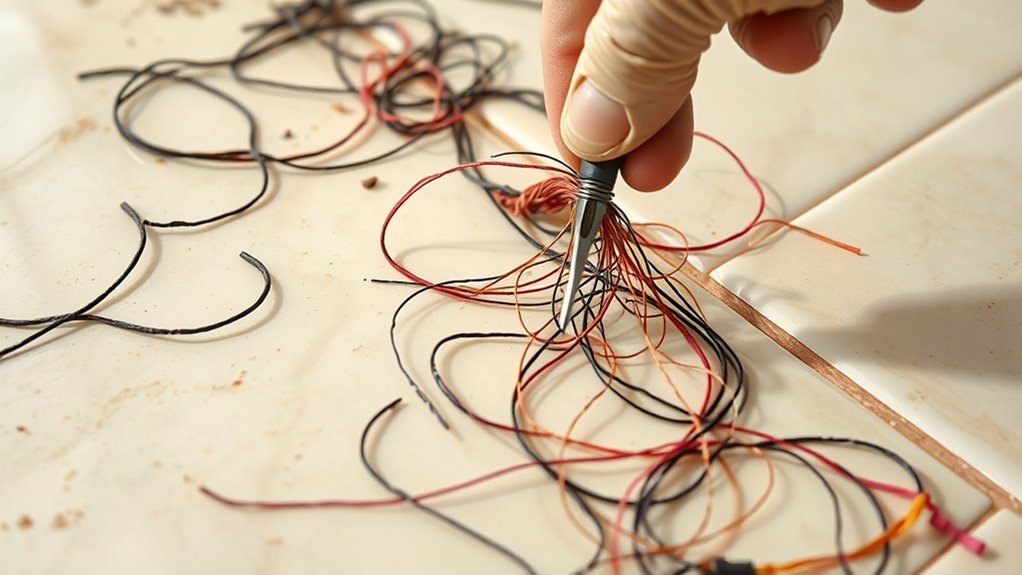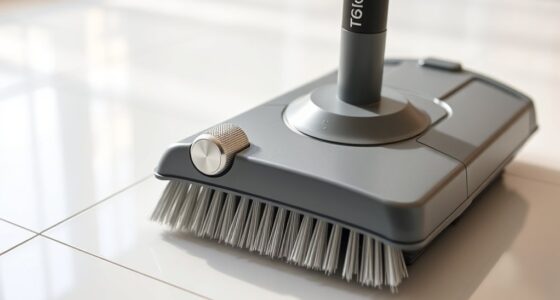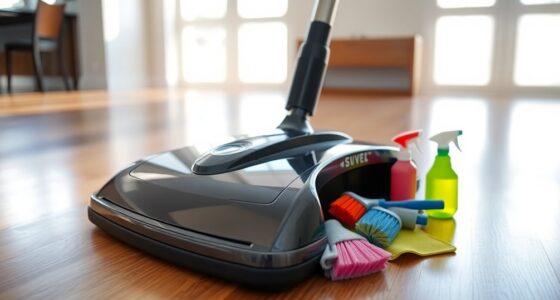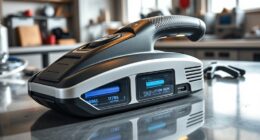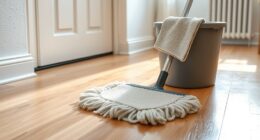To remove hair and string from tile floors without causing jams, start by adjusting your vacuum to a low or no-suction setting and use slow, overlapping passes. Employ handheld or crevice attachments for edges and tight spots, and gently lift fibers with a rubber broom or damp cloth to loosen debris beforehand. For stubborn residues, a soft brush or lint roller can help. For more tips on safe, jam-free cleanup, keep exploring these effective strategies.
Key Takeaways
- Use a rubber broom or damp cloth to loosen hair and strings before vacuuming.
- Set the vacuum to low or turn it off to prevent jams while cleaning fibers.
- Employ handheld or crevice attachments for precise removal along edges and tight spots.
- Gently lift fibers with a lint roller or small brush to prevent embedding or tangling.
- Regularly check and clear vacuum brush rolls to avoid jams and maintain effective cleaning.
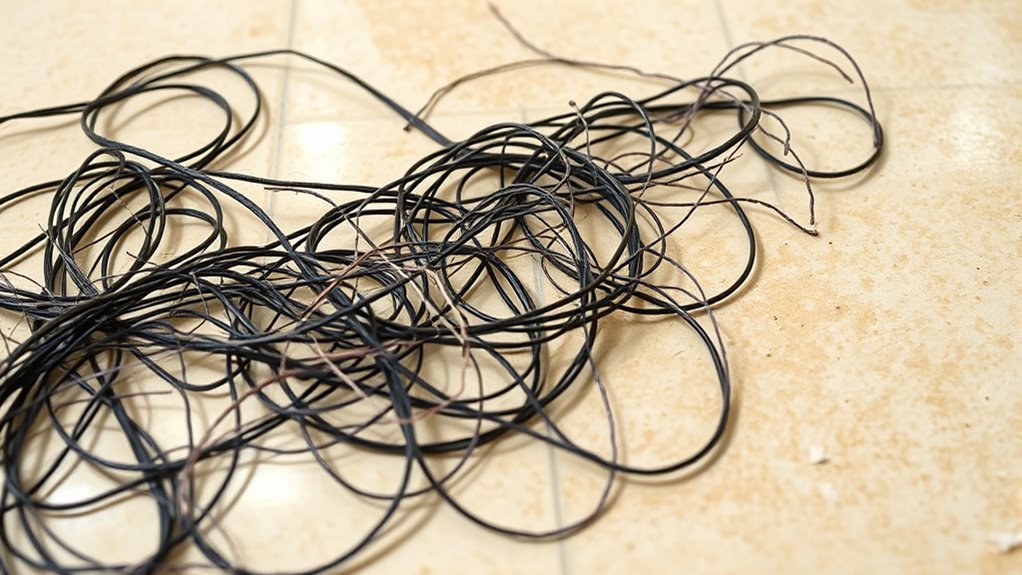
Have you ever noticed hair and string scattered across your tile floors? It’s a common annoyance, but the good news is that with the right vacuum techniques, you can tackle this problem efficiently. Traditional vacuuming might not always do the trick, especially when dealing with fine hair or string that tends to tangle or clog your vacuum’s brush roll. To avoid jamming, try adjusting your vacuum’s settings for tile floors, ensuring the brush is turned off or set to a low setting. This prevents the bristles from pulling in and tangling the hair and string, making your cleaning process smoother. When vacuuming, go slow and methodically, overlapping each pass to pick up every strand. Use a handheld or crevice attachment for edges and tight spots—these are often overlooked but tend to accumulate hair and string the fastest. This precise approach minimizes the risk of jams and keeps your vacuum running smoothly.
Sometimes, despite your best vacuum techniques, stubborn string or hair may remain embedded or tangled. In these cases, stain removal methods come into play. For any residue or stubborn fibers, a simple trick is to use a rubber broom or a damp cloth to loosen and lift hair and string before vacuuming again. The rubber creates static that attracts hair, making it easier to gather. For sticky or stubborn stains caused by hair or string residues, a mixture of warm water and a mild detergent can be effective. Lightly dampen a cloth with this solution and gently wipe the area. This not only helps lift any remaining debris but also prevents buildup that could trap more hair and string in the future. If you notice any residue that’s difficult to remove, avoid harsh chemicals that could damage your tiles; instead, stick with gentle solutions and avoid scrubbing aggressively, which can scratch the surface.
A key part of preventing hair and string from becoming a persistent problem is regular maintenance. Incorporate routine vacuuming with the right techniques to keep your tiles clear. Consider using a lint roller or a handheld lint remover on the surface for quick cleanups in high-traffic areas. Also, keep a small brush or comb nearby to manually gather any stubborn fibers or strands that the vacuum misses. When you combine proper vacuum techniques with effective stain removal methods, you’ll find it much easier to keep your tile floors looking pristine. Remember, patience and consistency are your best tools—by staying proactive and gentle, you’ll prevent jams and ensure a clean, hair-free surface every time.
Frequently Asked Questions
Can I Use a Vacuum to Remove Hair and String From Tile Floors?
Yes, you can use a vacuum to remove hair and string from tile floors. For easier hair removal, try using a vacuum with a brush attachment or a handheld model. If you prefer vacuum alternatives, a rubber broom or damp microfiber cloth can help lift stubborn hair and string. Remember, regular hair removal tips include sweeping or using these tools to prevent buildup and keep your floors tidy.
What Household Tools Are Safest for Removing Stubborn Hair and String?
You can safely remove stubborn hair and string with household tools like a rubber glove, which provides effective removal by sticking to the hair and string. A pair of tweezers also works well for precision, but make sure you’re gentle to maintain household tool safety. For effective removal techniques, avoid sharp or metal tools that might scratch the tile. Using these safe, simple tools keeps your floors clean without damage.
How Often Should I Clean Tile Floors to Prevent Hair and String Buildup?
Think of your tile floors as a garden that needs regular tending. You should clean them at least twice a week to prevent hair and string from taking root and becoming stubborn weeds. Maintaining a consistent schedule keeps your floors looking fresh and makes removal easier. Regular cleaning not only preserves their beauty but also reduces the effort needed for deep cleans, making your home a more comfortable, inviting space.
Are There Specific Products Recommended for Removing Hair and String?
You should use specialized cleaning tools, like a rubber broom or a microfiber mop, to effectively remove hair and string from tile floors. Pet hair removers, such as handheld lint rollers or rubber gloves, work great for quick cleanup. These products help loosen and lift hair and string without jamming, making your cleaning faster and more efficient. Regular use of these tools keeps your floors hair-free and easy to maintain.
Will Using Water or a Wet Mop Help Loosen Hair and String Effectively?
Did you know that using a damp mop can boost cleaning effectiveness by up to 30%? Water dampening helps loosen hair and string from tile floors, making removal quicker and easier. Applying a little water or a wet mop softens debris, reducing the chances of jamming or spreading it around. So, yes, using water or a damp mop is an effective way to loosen hair and string effortlessly.
Conclusion
Remember, a little patience goes a long way when removing hair and string from tile floors. By using the simple method outlined, you’ll keep your floors tidy without frustration. Don’t forget, Rome wasn’t built in a day—so take your time and stay consistent. With a steady hand and a bit of persistence, your floors will look pristine again. Keep at it, and you’ll enjoy a clean, beautiful space in no time.
